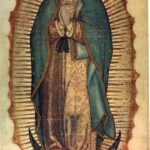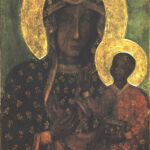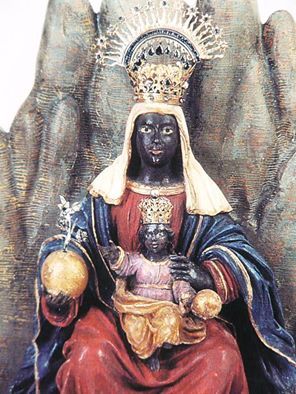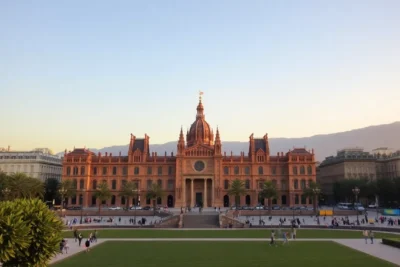
- The Cultural Significance of the Black Madonna in Art and Religion
- Exploring the Origins: The History Behind the Black Madonna
- Unraveling the Mystery: Why is She Called the Black Madonna?
- The Symbolism of the Black Madonna: Colors and Meanings
- Black Madonna: A Spiritual Icon Across Different Cultures
- Contemporary Interpretations of the Black Madonna's Image
The phenomenon of the Black Madonna has captivated many across cultures and centuries, embodying a rich tapestry of spirituality, mystery, and artistic expression. The iconography of these revered figures often raises questions regarding their origins and the symbolism behind their dark skin.
In exploring the complexities surrounding this enigmatic representation, we delve into the significance and cultural implications that give rise to the moniker. Thus, we embark on a journey of discovery in The Enigma Unveiled: Why is it called Black Madonna? to uncover the layers of meaning that lie beneath the surface of this profound image.
The Cultural Significance of the Black Madonna in Art and Religion
The Black Madonna holds a unique position in both art and religion, symbolizing the intersection of various cultural narratives and spiritual beliefs. These figures are often depicted in a striking visual style that emphasizes their dark skin, which has provoked numerous interpretations regarding their significance. The cultural significance of the Black Madonna can be recognized in several ways:
- Representation of Diversity: The Black Madonna serves as a reminder of the diversity within the Christian faith, celebrating different expressions of devotion.
- Maternal Symbolism: She embodies the nurturing aspects of motherhood, often associated with fertility and compassion in various cultures.
- Spiritual Resilience: Many see her as a symbol of resilience and hope, particularly in communities that have faced oppression and adversity.
In artistic representations, the Black Madonna often features intricate iconography that emphasizes her significance. Artists have incorporated elements such as:
- Gold and vibrant colors to signify divinity and the sacred.
- Symbols of nature, which link her to the earth and fertility.
- Unique poses and gestures that convey various spiritual messages.
In religious practices, the Black Madonna is often venerated in various traditions, demonstrating her importance across different faiths. Churches and shrines dedicated to her attract pilgrims who seek spiritual solace and healing. This act of pilgrimage further highlights her role as a beacon of faith, bridging communities and fostering a sense of belonging among those who honor her.
Exploring the Origins: The History Behind the Black Madonna
The origins of the Black Madonna can be traced back to various historical and cultural influences that converge to form this captivating icon. While many of these figures are rooted in the Christian tradition, their depictions often reflect intertwining traditions from pre-Christian beliefs, particularly from ancient cultures that revered mother goddesses. This fusion highlights the adaptability of sacred symbols across different eras and religious frameworks.
In addition to their spiritual significance, the Black Madonnas are often associated with specific geographic regions, leading to diverse interpretations. For example, in Europe, particularly in France and Spain, these figures are historically linked to sites of pilgrimage and healing. The devotion surrounding them often stems from local legends that weave together themes of miraculous interventions and divine protection, further solidifying their meaningful legacy.
Interestingly, the color of the Black Madonna has prompted various theories regarding its symbolism. Some scholars suggest that the dark skin represents earthiness and fertility, connecting her to the natural world. Others argue that it signifies the universality of the divine, transcending racial boundaries and promoting inclusivity within the faith. This rich tapestry of interpretations enhances the mystique surrounding her image.
In a more contemporary context, the Black Madonna serves as a potent symbol in discussions around social justice and empowerment. Her portrayal resonates particularly within marginalized communities, where she is viewed not only as a religious figure but also as an emblem of resilience against historical oppression. This duality is a testament to her enduring relevance, bridging the past with today's struggles for equality and recognition.
Unraveling the Mystery: Why is She Called the Black Madonna?
The term "Black Madonna" has sparked intrigue and curiosity among scholars and devotees alike, leading to various interpretations of its significance. This name typically refers to depictions of the Virgin Mary with dark skin, which raises questions about the cultural and historical contexts from which these images emerge. Understanding why she is called the Black Madonna requires us to explore the interplay of faith, race, and art throughout history.
One prevalent theory suggests that the color black is symbolic of divine mysteries. In many cultures, the color black is associated with the unknown and the sacred, representing the protective and nurturing aspects of the Divine Mother. This association invites deeper reflection on the multifaceted nature of femininity and spirituality, emphasizing the need to embrace all forms of representation within religious art.
In addition to symbolic interpretations, regional variations of the Black Madonna have unique narratives and local legends that contribute to her mystique. Notable examples include:
- Our Lady of Częstochowa: A revered icon in Poland associated with miraculous healing.
- Our Lady of Montserrat: A figure in Spain that symbolizes political resistance and cultural identity.
- Our Lady of Black Nazarene: A popular image in the Philippines, reflecting the deep faith and devotion of its people.
These diverse representations illustrate how the Black Madonna transcends cultural boundaries, becoming a unifying figure for those who seek solace and empowerment. Her enduring legacy continues to inspire discussions around identity and inclusivity, reminding us of the rich tapestry of beliefs that shape our understanding of the Divine.
The Symbolism of the Black Madonna: Colors and Meanings
The Black Madonna's color symbolism plays a crucial role in understanding her significance across cultures and religious traditions. The use of dark hues often embodies deep spiritual meanings, transcending mere aesthetic choices. For many, the color black represents mystery and the unknown, inviting a sense of reverence and contemplation about the divine feminine and her role in the cosmos.
Moreover, the color black is frequently associated with earthiness and fertility, connecting the Black Madonna to the cycles of nature and human life. This symbolism can be crucial for communities that have historically viewed her as a source of strength and nurturing. The duality of her representation encompasses both the material and spiritual realms, bridging the tangible with the ethereal.
In many interpretations, the Black Madonna serves as an emblem of unity and inclusivity within the Christian faith. Her dark skin invites followers to embrace the universality of the divine, challenging racial and ethnic boundaries. This broader representation encourages a dialogue around acceptance and the celebration of diversity within spirituality.
Additionally, the intertwining of cultural narratives and colors associated with the Black Madonna enriches her story. She is often depicted alongside symbols that further enhance her meaning, such as:
- Gold decorations: Signifying divinity and the sacred.
- Natural motifs: Emphasizing her connection to the earth and life-giving forces.
- Unique gestures: Conveying messages of compassion, protection, and empowerment.
Black Madonna: A Spiritual Icon Across Different Cultures
The Black Madonna serves as a profound spiritual icon across various cultures, symbolizing both divinity and humanity. Her image resonates deeply within communities, often intertwining with local beliefs and traditions. This iconic figure transcends geographic boundaries, manifesting in distinct forms that reflect the cultural narratives of the people who venerate her, thereby highlighting the rich diversity within spiritual practices.
Many cultures attribute a multitude of meanings to the Black Madonna, enhancing her significance as a spiritual symbol. For example, she is often viewed as a protector and a source of comfort for those facing hardships. In regions such as Africa and Latin America, her image is embraced as a representation of resilience and strength, particularly for marginalized communities seeking empowerment and solace through their faith.
The Black Madonna's presence in various artistic expressions also contributes to her spiritual allure. Artists often employ vibrant colors and intricate designs to convey her multidimensionality. These visual elements serve to not only celebrate her divine nature but also to emphasize her connection to the natural world, reinforcing her role as a maternal figure who nurtures both the spirit and the earth.
Ultimately, the Black Madonna embodies a rich tapestry of meanings that reflect the intertwining of faith, culture, and identity. Through her diverse representations, she invites individuals to explore the complexities of spirituality, encouraging a deeper understanding of the divine that is inclusive and representative of all humanity. The enduring legacy of the Black Madonna continues to inspire dialogue about cultural significance and the universal quest for connection with the sacred.
Contemporary Interpretations of the Black Madonna's Image
Contemporary interpretations of the Black Madonna's image reflect a diverse array of cultural and spiritual contexts. In today's society, she is increasingly recognized as a symbol of empowerment and resilience for marginalized communities. This relevance is evident in how artists and activists have embraced her image to advocate for social justice and inclusivity, making her a powerful figure in movements aimed at challenging systemic inequality.
Many contemporary artists reinterpret the Black Madonna through various mediums—painting, sculpture, and digital art—infusing her imagery with modern themes. These works often emphasize her role as a nurturing figure while addressing contemporary issues such as gender equality and racial justice. The incorporation of elements like:
- Abstract forms: To signify the fluidity of identity.
- Urban landscapes: Highlighting the intersection of spirituality and daily life.
- Vibrant colors: To evoke emotions related to hope and resilience.
These artistic choices not only celebrate her legacy but also invite new interpretations that resonate with today's audience.
Moreover, the Black Madonna's image has become a focal point for discussions around feminism and the divine feminine. Many contemporary spiritual movements embrace her as an archetype representing the sacred feminine, encouraging women to connect with their own power and wisdom. This reinterpretation highlights the ongoing relevance of her figure in fostering a deeper understanding of womanhood and spirituality in the modern age.
In a global context, the Black Madonna's significance is also evident in various cultural celebrations and festivals. These events often highlight themes of unity and community strength, drawing diverse participants together to honor her legacy. The shared experiences surrounding these gatherings reaffirm her role as a unifying figure, bridging different cultures and traditions while fostering a sense of belonging among those who seek her guidance.
 The Mystery Behind Montserrat's Low Population: Unraveling the Enigma
The Mystery Behind Montserrat's Low Population: Unraveling the Enigma Discovering Barcelona with a Hop-On Hop-Off Bus Tour
Discovering Barcelona with a Hop-On Hop-Off Bus Tour Plan your trip to Barcelona for an unforgettable experience
Plan your trip to Barcelona for an unforgettable experience The Enigma Unveiled: Exploring Why the Black Madonna is Famous
The Enigma Unveiled: Exploring Why the Black Madonna is Famous The Enigma Unveiled: Decoding the Mystery of the Black Madonna
The Enigma Unveiled: Decoding the Mystery of the Black Madonna The Black Madonna: Exploring the Patron Saint's Significance and Meaning
The Black Madonna: Exploring the Patron Saint's Significance and MeaningIf you want to know other articles similar to The Enigma Unveiled: Why is it called Black Madonna? you can visit the category Blog.
Deja una respuesta









Read more!